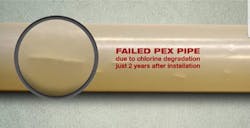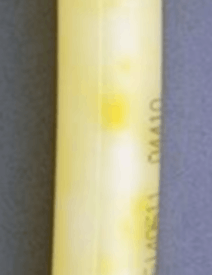Recognizing the Signs that a Repipe Should be Recommended
By Jonathan Simon
The decision to recommend a repipe isn’t always an easy one. Some of the signs that a problem may be systemic can be subtle and vary for different plumbing materials. Determining whether a particular failure is isolated or indicative of a larger problem requires accurately identifying the root cause. Here are some of the causes of plumbing failures and what they can tell you about the potential for future failures.
Installation Errors
Installation errors don’t always show up immediately after the water is turned on. Some can take years to reveal themselves through a failure, particularly mistakes related to accounting for expansion and contraction and in joining pipes and fittings.
With PEX, fitting issues can result from improper seating or crimping of fittings. With CPVC, the issue can occur if the installer forgets to apply solvent cement or applies an extreme amount of solvent cement before connecting the pipe to the fitting.
With both systems, the failure could either represent an isolated error in an otherwise proper installation or could be a sign of an inexperienced plumber who repeated the same mistake with every fitting. In these cases, service plumbers should investigate other fittings in the system for similar errors.
Both CPVC and PEX expand and contract with temperature changes, including thermal cycling of hot and cold water, and even ambient temperature changes from the initial installation to the in-service air temperature. When expansion and contraction is restricted, the physical stress can exceed material specifications. The stretching or compressing force on a pipe from thermal expansion and contraction can exceed 1200 psi under the right circumstances.
In a CPVC system, these failures will only occur if expansion and contraction were not properly accounted for in the installation. They can be identified by looking for fittings, such as 90⁰ elbows or tees, that have been distorted from their original angle due to the force of expansion. They are typically isolated to one run of pipe, but it is worth investigating other fittings in the system to ensure they aren’t also being distorted by thermal expansion.
Chemical Incompatibility
For example, with CPVC this could involve the improper use of vinyl-coated or rubber hangers, which can contain plasticizers that soften the pipe. When using FlowGuard Gold® and Corzan® CPVC, use the FBC™ System Compatible Program to identify materials that are both compatible and incompatible. PEX is known to have compatibility concerns with closed-cell insulation, organic chemicals, strong acids, strong bases, solvents, petroleum distillates and adhesive tapes.
Less likely are exposures within the inside of the pipe that could occur if the water becomes contaminated with incompatible chemicals, such as those in some solvents, plasticizers or petroleum-based oils. These situations areWater Incompatibility
Water incompatibility is a form of chemical incompatibility in which the interior of the pipe is gradually degraded by the disinfectants added to water to make it safe for drinking, most notably chlorine,This was the problem with polybutylene piping, which was popular at one time but then was pulled off the market in the 1990s after being the subject of the largest class action lawsuit settlement ever awarded for a building material. Most polybutylene pipes have already been replaced, but some still remain in service. If you encounter polybutylene, a complete repipe is strongly recommended.
For PEX and copper, failures often appear first in areas where water temperatures and pressures are highest, and then spread to other areas of the system.
Homeowners may not want to hear that a repipe is their best option after a single failure, especially if their system is still within its expected service life, but failures caused by water incompatibility in systems less than 20 years old tend to be systemic. To identify chlorine degradation in a PEX pipe, look for cracking along the length of the pipe, permeation of the print line into the inner wall of the pipe and “popcorning” or yellow pockmarking of the exterior wall of the pipe. These are all signs of degradation that are likely to be systemic.
Water incompatibility in copper pipes typically exhibits first as pinhole leak that leads to cracking of the pipe.
Aged Pipe
Plumbers may face a decision whether the age of the system makes a repipe warranted. This decision should generally be driven by the performance of the system and factors unique to each material. While discoloration in PEX can be a sign of chlorine degradation, in CPVC systems a change in color is a fairly common occurrence that has no bearing on the life expectancy of the system.
CPVC is immune to degradation caused by chlorinated drinking water but may experience discoloration and become more rigid with age. These changes affect the way the pipe should be handled in service, but do not introduce vulnerability into a properly installed and serviced system. When servicing older CPVC pipe, the manufacturer recommends using a C-style tubing cutter to compensate for the increased rigidity. A fine-tooth saw or wheel cutter can also be used—ratcheting and scissors-style tubing cutters should never be used when servicing a CPVC system. When cut properly, older CPVC can typically remain in service without issue.
What to Remember
If you encounter failed CPVC, the cause is almost always installation error or chemical incompatibility. With PEX and copper, water incompatibility issues can be a leading culprit. With each material, proper servicing is essential to a successful repair, and using practices not recommended by the manufacturer can result in challenges on the jobsite.
If the pipe is showing signs of water incompatibility, this is most likely a systemic problem that will only be resolved by removing the incompatible material or dechlorinating the water. If a system has demonstrated incompatibility with local water conditions, contractors should consider adding a water filtration system specifically designed to address the method of disinfection used by the local water utility—or simply use an alternate piping material that is immune to chlorinated drinking water.




